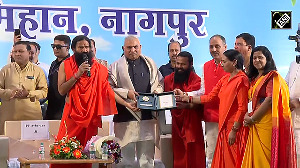Dr P Chandra Sekaran, the former director of the Tamil Nadu forensic department, explains the importance of forensics in rape case. Vicky Nanjappa reports.
While the nation debates laws to strengthen punishments for rapists, one of the most crucial factors in any investigation is the data provided by the forensic sciences laboratory.
Elaborating on the importance of forensics Padma Bhushan Dr P Chandra Sekaran, the former director of the Tamil Nadu forensic department says that if the victim manages to bite the rapist it could go on to become the most crucial evidence during the trial.
The bite mark often lasts for 14 days. When a person is bitten, the capillary vessels are broken leaving a blue coloration, which identifies the shape of the teeth.
The police in turn will have to take the accused to a dentist, who will examine the marks. This is a process known as forensic dentistry and was last used in 1980 when a group of doctors from Japan visited India and trained 50 experts. However, this method has not been developed further and in the given circumstance where there is often a problem of vanishing evidence it would go a long way in helping the case.
However, there is always this argument about the authenticity of the bite. It was argued in one of the cases that the victim had inflicted a bite mark on the accused. However, a forensics expert can easily identify between different kinds of bites. In a bite involving a struggle the accused would try and drag and resist the bite, which makes the mark elongated.
Dr Sekaran also says that the bone marrow test to determine the age of a juvenile is not foolproof, as India lacks expertise in this department.
The vaginal swab is very crucial to an investigation involving a rape case as it makes for a DNA record. If the victim is shy to go to a doctor then the vaginal swab can be taken by her and then handed over to the police. The police in turn could take it to the forensic sciences and determine the DNA and proceed with the case.
In case, the vaginal swab cannot be obtained, then the victim could also hand over the clothes she was wearing at the time of the incident to the police.
For determination of a vaginal swab or the clothes of the victim there is no requirement for doctor's evidence. It can be given to the police and they in turn could take it to the forensics sciences laboratory for examination. However, this is just one part of the investigation and the police cannot rely on this piece of evidence alone to make a case. The role of a doctor would come into play only to determine the injury on the victim.
Determining the age of a rape accused:
The Delhi police have said that the juvenile accused in the gang-rape of the 23-year-old medical student would have to undergo an age determination test. However, this has not always proven effective, as there is no foolproof test available in India.
In India, the ossification test, based on the formation of bones, is used to determine the age of a person. In a person below the age of 18, normally the end of the bone or the iliac crust is not formed. However, this is not entirely dependant on the age alone.
Ossification also depends on food habits, hereditary factors and climatic conditions. At times, the bone could be well formed before the age of the 18 and no radiologist can determine the exact age.
The amendment to the Juvenile Justice Act, which states any person below the age of 18 is not an adult, is the need of the hour. This act should be restricted to property and other offences and not rape. In a rape case, the factor that has to be taken into consideration is the desire to have sex and if there is such a desire then he cannot be termed as a minor and the normal provisions of law under the Indian Penal Code should be made applicable.







 © 2025
© 2025